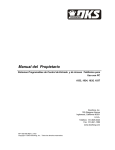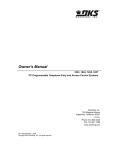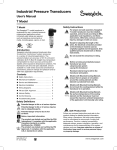Download Omega Vehicle Security LV132 User's Manual
Transcript
LV132 Electro-Optic Conductivity Sensor Instruction Sheet M1800/1299 DESCRIPTION The compact, LV132 Conductivity Sensor, with built-in electronics, is ideal for leak detection applications. It combines electro-optic and conductive technologies and can discriminate between hydrocarbons and water. The sensor is compatible with a broad range of conductive and non-conductive liquids. It is also suitable for high, low or intermediate level detection in practically any tank - large or small. Installation is simple and quick through the tank top, bottom or side. With no moving parts, the sensor is ideal for interstitial applications. The pull ring facilitates easy installation in double-wall tanks and pipes, yet can be removed for use in 1/4" NPT holes. SENSOR OPERATING PRINCIPLE The sensor has the capability of discriminating between conductive and non-conductive liquids, such as water and gasoline. Conductivity probes are used in conjunction with an optical prism, consisting of a light-emitting diode and phototransistor. The prism detects liquid via a loss of light intensity on the phototransistor (due to refraction). The sensor has two outputs: one for conductive liquid and one for non-conductive liquid. Both outputs are TTL/CMOS compatible. WARNING The nature of the sensor is that it is a non-voltage producing device, containing limited energy-storing components. However, since its primary use is in a hazardous location, an appropriate intrinsically safe interface device must be used and installed in strict accordance with the National Electrical Code and applicable OMEGA technical brochure and instruction bulletin. Failure to observe this warning could result in serious injury or damages. UNPACKING Remove the Packing List and verify that you have received all equipment. If you have any questions about the shipment, please call the OMEGA Customer Service Department at 1-800-622-2378 or (203) 359-1660. When you receive the shipment, inspect the container and equipment for any signs of damage. Note any evidence of rough handling in transit. Immediately report any damage to the shipping agent. NOTE The carrier will not honor any claims unless all shipping material is saved for their examination. After examining and removing contents, save packing material and carton in the event reshipment is necessary. INSTALLATION - Running of Field Wire A. The conductors of the intrinsically safe circuit should be sealed in a rigid metal conduit at the point where the wiring enters the hazardous area. The wiring and contacting device should be such that conductive dusts in the area will not close the circuit in place of the contacts. B. Hazardous area field wiring will store energy due to distributed capacitance and inductance in proportion to its length. The maximum run of cable has been defined at 750 feet between barrier and sensor. C. Shielded cable is not required, but if used in the application, the shield must be returned to ground. The shield must be connected to barrier earth ground. D. Intrinsically safe wiring must be installed in accordance with Article 504 of the NEC, ANSI/NFPA-70 or CEC Part 1, as applicable. All intrinsically safe wiring must have 0.01 inch minimum insulation thickness. Non-intrinsically safe wiring cannot be run in conduit or open raceways together with intrinsically safe wiring. U.L. Entity Parameters For CSA intrinsic safety approval, the following barriers must be used: Terminal Vmax Imax Red/Black 38V 150mA Green/Black 38V 150mA White/Black 38V 150mA SBG111950 and SBG111954 Ci .052µ .052µ .052µ Li 0 0 Vmax ≥ Voc (barrier) 0 Li + Lcable < (LA barrier) Imax ≥ Isc (barrier) Ci + Ccable < ( CA barrier) Zener Barrier Wiring Diagram Zener Barrier* + Red _ DC Power Supply GND Note Source voltage not greater than 250 VAC. Zener barriers must be installed in accordance with barrier manufacturer's instructions. Earth Ground Black Green Non-Conductive Liquid Output White Earth Ground Zener Barrier** *Use OMEGA P/N SBG111954 for CSA approval. Conductive Liquid Output **Use OMEGA P/N SBG111950 for CSA approval. Earth Ground Sensor Pulled Through Interstitial Space of Double-Wall Tank INSTALLATION - Sensor When installed in accordance with this installation procedure, the sensor is suitable for use in Class I, Division 1, Groups C and D. 1. With protective shield attached, sensor can be pulled through interstitial space of double-wall tank. Sensor can also be placed loose in tank or reservoir. 2. Sensor may be installed in horizontal or vertical positions, only. 3. Do not install sensor close to infrared sources. 4. Prism surface must be at least 2" from any reflective surfaces. 5. Connect 10-28 VDC power to red lead; return to ( ) black lead. Controller LV132 Tip MAINTENANCE Sensor may require a periodic cleaning of prism surface. Chlorinated hydrocarbons must not be used for cleaning. A mild detergent may be used to clean prism surface. SPECIFICATIONS TEMPERATURE RANGES • Input Voltage: 10-28 VDC Current Consumption: Approximately 17mA Output: TTL/CMOS Compatible Output may sink 100mA up to 28 VDC (°F) (°C) 0°F to 176°F -17.8°C to 80°C • Not for use in freezing conditions (See Temperature Ranges) • Materials in contact with fluids are polysulfone, plastic, PVC, PRESSURE RANGE 0 to 50 PSI, Max. stainless steel and polyolefin. • Repeatability: ±1mm DIMENSIONS 0.62" (15.75mm) 3.22" (81.79mm) Conductivity Sensors Cable (4) Conductor (PVC Jacket) 25 Ft to 25.5 ft Extended (7.62 to 7.77m extended) 1.10" (27.94mm) 1/4" NPT Optional LV132 Tip Electro-Optic Conductivity Sensor Red: 10-28 VDC Black: Ground Green: Fuel/Oil White: Conductive Output Label (Electrical Rating) P/N 156837






